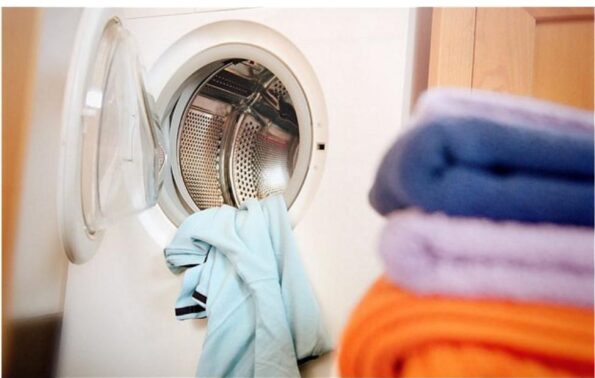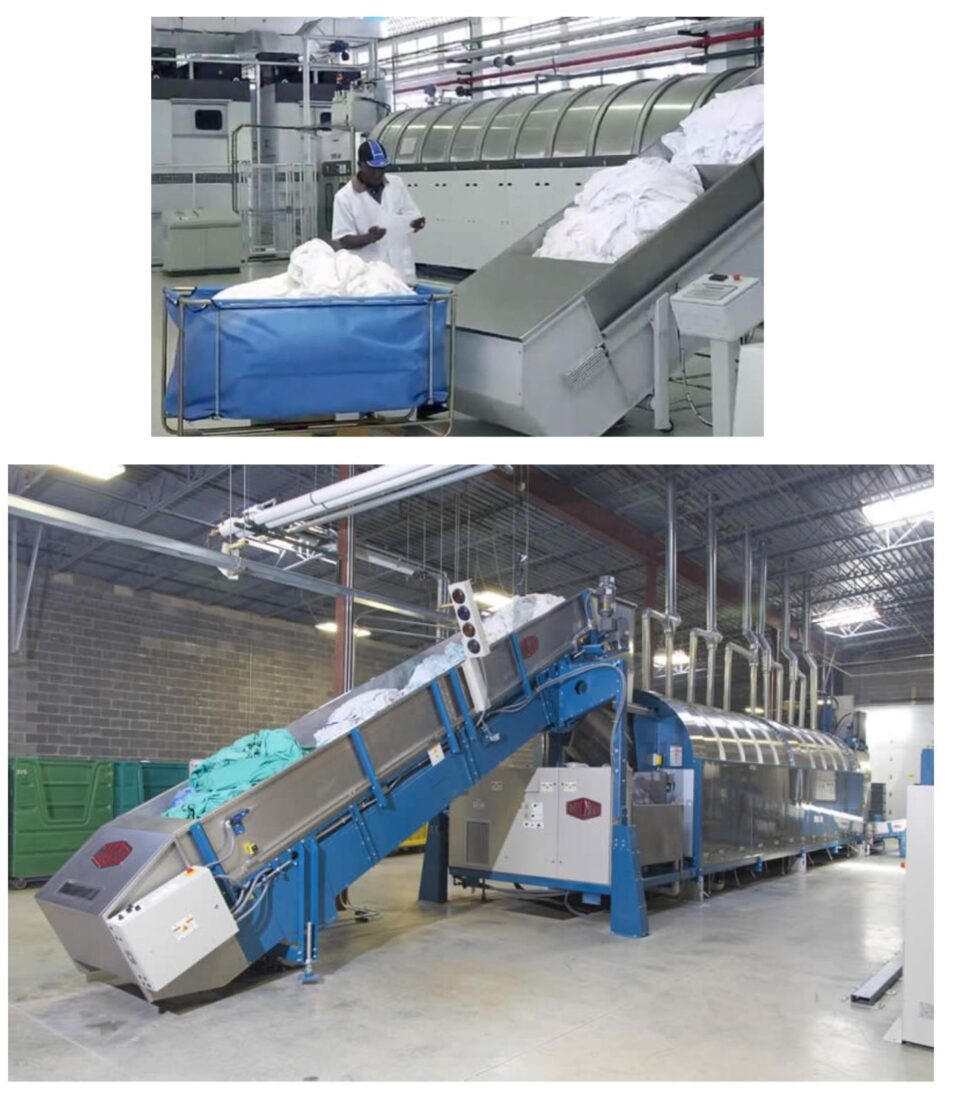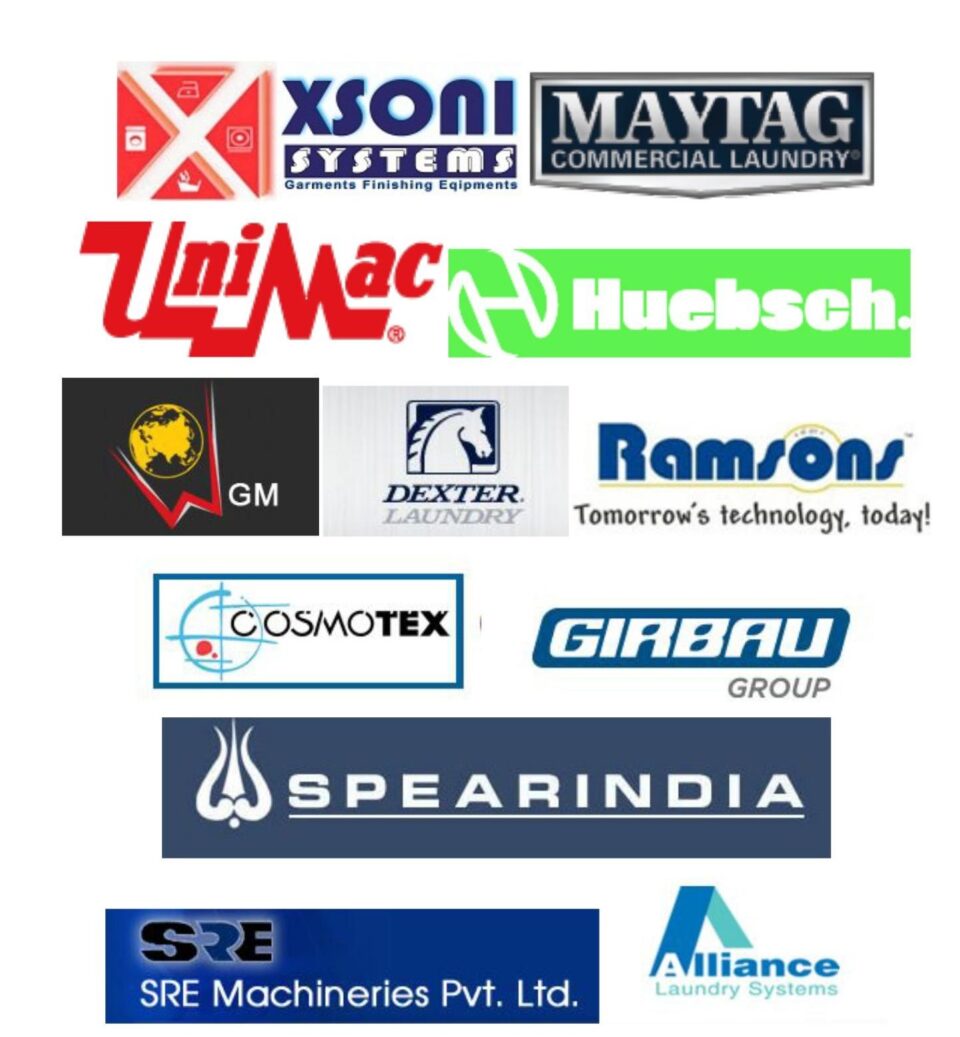Washing is a process which changes outer appearance, comfort, feel of the garment. Wash types usually depend on the product nature and usage. Based on consumer demand and fashion trends buyers fix washing type of any product.
Garment wash here refers to garment pre- wash performed after production of garment’s prior to using it for the consumers.
The main objectives of garment washing are as follows-
- To remove stiffness and roughness in some garments which aren’t pre – washed.
- Different washing methods are being used to provide a different or customised appearance.
- Softness can be increased by addition of softeners.
- During manufacturing dirt, spot or oil mark may get added with the garment’s which gets eliminated by washing process.
- To eliminate starch and chemicals which are used during fabric manufacturing and dying process.
- Due to washing, maximum shrinkage occurs; hence there is zero possibility of further shrinkage. As a result, there is no size or fitting problem in washed garments.
- WASHING MACHINES –
Washing machine (laundry machine, clothes washer, or washer) is a machine used to wash laundry, such as clothing and sheets.
2.1 Top-loading-
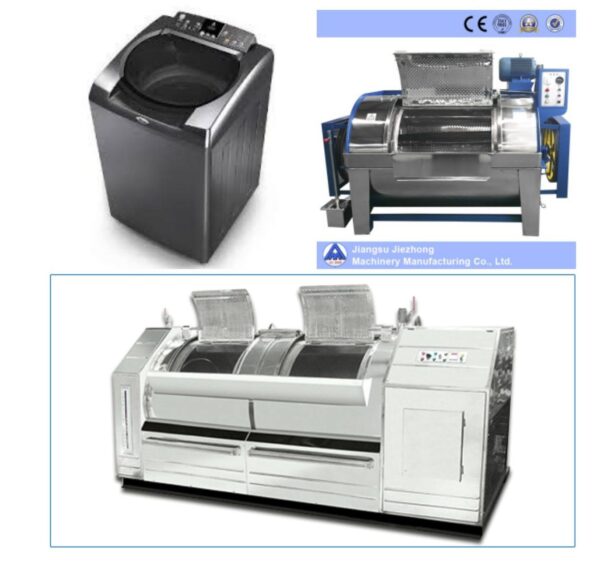 In a top-loading washer, water circulates primarily along the poloidal axis during the wash cycle, as indicated by the red arrow in this illustration of a torus.
In a top-loading washer, water circulates primarily along the poloidal axis during the wash cycle, as indicated by the red arrow in this illustration of a torus.
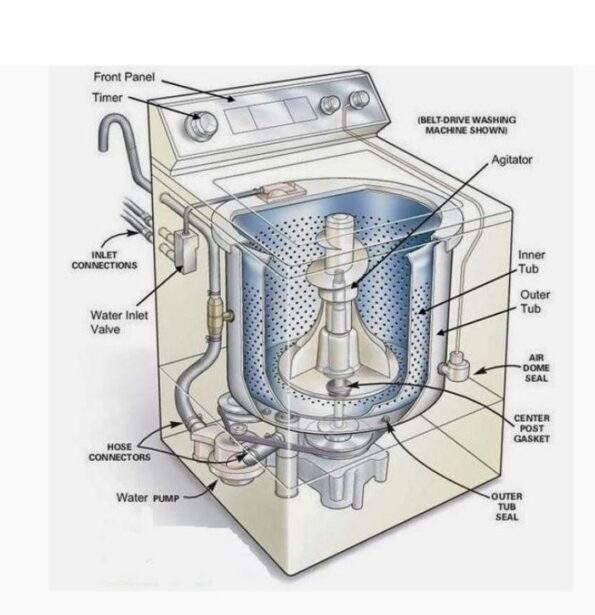 Parts of a Top loading washing machine
Parts of a Top loading washing machine
2.1.1 Working-
- This design places the clothes in a vertically mounted perforated basket that is contained within a water-retaining tub, with a finned water-pumping agitator in the centre of the bottom of the basket.
- Clothes are loaded through the top of the machine, which is usually but not always covered with a hinged door.
- During the wash cycle, the outer tub is filled with water sufficient to fully immerse and suspend the clothing freely in the basket.
- The movement of the agitator pushes water outward between the paddles towards the edge of the tub. The water then moves outward, up the sides of the basket, towards the centre, and then down towards the agitator to repeat the process, in a circulation pattern similar to the shape of a torus.
- The agitator direction is periodically reversed, because continuous motion in one direction would just lead to the water spinning around the basket with the agitator rather than the water being pumped in the torus-shaped motion.
In most top-loading washers, if the motor spins in one direction, the gearbox drives the agitator; if the motor spins the other way, the gearbox locks the agitator and spins the basket and agitator together. Similarly, if the pump motor rotates one way it re-circulates the sudsy water; in the other direction it pumps water from the machine during the spin cycle. Because they usually incorporate a gearbox, clutch, crank, etc., top-loading washers are mechanically more complex than front loading machines.
2.1.2 Advantages-
- The top-loader’s spin cycle between washing and rinsing allows an extremely simple fabric softener dispenser, which operates passively through centrifugal force and gravity.
- Another advantage to the top loading design is the reliance on gravity to contain the water, rather than potentially trouble-prone or short-lived front door seals. Top loaders may require less periodic maintenance, since there is no need to clean a door seal or bellows, although a plastic tub may still require a periodic “maintenance wash” cycle.
- As with front-loading washers, clothing should not be packed tightly into a top-loading washer. Although wet fabric usually fits into a smaller space than dry fabric, a dense wad of fabric can restrict water circulation, resulting in poor soap distribution and incomplete rinsing. Extremely overloaded top-loading washers can either jam the motion of the agitator, overloading or damaging the motor or gearbox, or tearing fabrics. Extreme overloading can also push fabrics into the small gap between the underside of the agitator and the bottom of the wash basket, resulting in fabrics wrapped around the agitator shaft, possibly requiring agitator removal to unjam.
Front-loading-
In the U.S. and elsewhere, most “high-end” washing machines are of this type. In addition, most commercial and industrial clothes washers around the world are of the horizontal-axis design.
2.2.1 Working-
- This layout mounts the inner basket and outer tub horizontally, and loading is through a door at the front of the machine. The door often but not always contains a transparent window.
- Agitation is supplied by the back-and-forth rotation of the cylinder and by gravity. The clothes are lifted up by paddles on the inside wall of the drum and then dropped. This motion flexes the weave of the fabric and forces water and detergent solution through the clothes load.
- Because the wash action does not require the clothing be freely suspended in water, only enough water is needed to moisten the fabric. Because less water is required, front-loaders typically use less soap, and the repeated dropping and folding action of the tumbling can easily produce large amounts of foam or suds.
Front-loaders control water usage through the surface tension of water, and the capillary wicking action created in the fabric weave. A front -loader washer always fills to the same low water level, but a large pile of dry clothing standing in water will soak up the moisture, causing the water level to drop. The washer then refills to maintain the original water level. Because it takes time for this water absorption to occur with a motionless pile of fabric, nearly all front-loaders begin the washing process by slowly tumbling the clothing under the stream of water entering and filling the drum, to rapidly saturate the clothes with water.
2.2.2 Advantages-
- Front-loading washers are mechanically simple compared to top-loaders, with the main motor (a universal motor or drive motor) normally being connected to the drum via a grooved pulley belt and large pulley wheel, without the need for a gearbox, clutch or crank.
- Compared to top-loading washers, clothing can be packed more tightly in a front loader, up to the full drum volume if using a cottons wash cycle. This is because wet cloth usually fits into a smaller space than dry cloth, and front loaders are able to self-regulate the water needed to achieve correct washing and rinsing. Extreme overloading of front-loading washers pushes fabrics towards the small gap between the loading door and the front of the wash basket, potentially resulting in fabrics lost between the basket and outer tub, and in severe cases, tearing of clothing and jamming the motion of the basket.
2.2.3 Disadvantages–
- But front-load washers suffer from their own technical problems, due to the drum lying sideways. For example, a top loading washer keeps water inside the tub merely through the force of gravity pulling down on the water, while a front-loader must tightly seal the door shut with a gasket to prevent water dripping onto the floor during the wash cycle. This access door is locked shut during the entire wash cycle, since opening the door with the machine in use could result in water gushing out onto the floor. For front-loaders without viewing windows on the door, it is possible to accidentally pinch fabric between the door and the drum, resulting in tearing and damage to the pinched clothing during tumbling and spinning.
- Nearly all front-loader washers for the consumer market must also use a folded flexible bellows assembly around the door opening, to keep clothing contained inside the basket during the tumbling wash cycle. If this bellows assembly were not used, small articles of clothing such as socks could slip out of the wash basket near the door, and fall down the narrow slot between the outer tub and basket, plugging the drain and possibly jamming rotation of the inner basket.
- Retrieving lost items from between the outer tub and inner basket can require complete disassembly of the front of the washer and pulling out the entire inner wash basket. Commercial and industrial front-loaders used by businesses usually do not use the bellows, and instead require all small objects to be placed in a mesh bag to prevent loss near the basket opening.
- The bellows assembly around the door is a potential source of problems for the
consumer front-loader. The bellows has a large number of flexible folds to permit the tub to move separately from the door during the high speed extraction cycle. On many machines, these folds can collect lint, dirt, and moisture, resulting in mold and mildew growth, and a foul odor. Some front-loading washer operating instructions say the bellows should be wiped down monthly with a strong bleach solution, while others offer a special “freshening” cycle where the machine is run empty with a strong dosing of bleach. In the past, suggested remedies have included adding vinegar to the laundry detergent, running an empty cycle with bleach every few weeks, wiping the door gasket with a diluted bleach solution every other week, and leaving the front-loading washer door ajar between loads.
Variant and hybrid designs-
There are many variations of these two general themes. Top-loading machines in Asia use impellers instead of agitators. Impellers are similar to agitators except that they do not have the centre post extending up in the middle of the wash tub basket.
- Some machines which actually load from the top are otherwise much more similar to front-loading drum machines. They have a drum rotating around a horizontal axis, as a front-loader, but there is no front door; instead there is a lift able lid which provides access to the drum, which has a hatch which can be, latched shut. Clothes are loaded, the hatch and lid are closed, and the machine operates and spins just like a front-loader. These machines are narrower but usually taller than front-loaders, usuallyhave a lower capacity, and are intended for use where only a narrow space is available, as is sometimes the case in Europe.
- They have incidental advantages: they can be loaded without bending down; they do not require a perishable rubber bellows seal; and instead of the drum having a single bearing on one side, it has a pair of symmetrical bearings, one on each side, avoiding asymmetrical bearing loading and potentially increasing life.
- There are also combo washer dryer machines that combine washing cycles and a full drying cycle in the same drum, eliminating the need to transfer wet clothes from a washer to a dryer machine.
- In principle, these machines are convenient for overnight cleaning (the combined cycle is considerably longer), but the effective capacity for cleaning dry the clothing, but also needs to dry out the wash chamber itself. These machines can be fitted into small spaces, and many can be operated without dedicated utility connections.
2.3.1 Combo washer-
- A combo washer dryer (also known more simply as a washer-dryer in the UK) is a combination in a single cabinet of a washing machine and clothes dryer. It should not be confused with a “stackable” combination of a separate washing machine and separate clothes dryer.
- Larger batches of laundry are drastically reduced.
Typical features-
2.3.1.1 Front-loading design-
Most washer dryer combination units are of the front-loading design. This allows for easier access, better efficiency, and more effective washes than top-loading designs. Instead of just leaving the clothes to soak in the water throughout the entire wash, like a top-loading machine would do, the front-loading design tilts the drum on its side, so that the contents of the drum are repeatedly lifted in and out of the water throughout the wash cycle.
2.3.1.2 Condensation-based vent less drying system-
Most washer dryer combos are vent less and are designed with drying systems that work differently from the ordinary stand-alone (vented) dryer. Instead of venting moist hot air to the outside, like a conventional dryer would, the combo unit makes use of condensation similarly to condenser dryers. Hot dry air enters the drum from either the front or the rear, and evaporates some of the moisture from the tumbling clothing. This warm, damp air is then drawn through a condensing chamber, and the extracted water is flushed out the drain hose to the sink or through the plumbing lines. These units are easy to install under cabinets, in closets or anywhere with electricity.
Typically in separate-condenser dryers, cool air is used to cool down the process air from the inside drum and to condense the vapour. In combined washer dryer units, however, cold water is used instead. The water flows in the opposite direction to the air, allowing the air to cool and to release its moisture, which is pumped out along with the water used to cool the air. These machines normally take longer than regular dryers, because the combo unit has a smaller drum, so there is less volume to allow air circulation and the drum itself must be dried immediately after a wash cycle. This water-fed drying system consumes water for both the washing and drying phases of operation, and may not be suitable for areas where water is scarce.
2.3.1.3 Automatic sensors and systems-
Washer dryer combinations are normally built with a number of sensors and systems to automate much of the washing and drying cycles. Some of the higher model washer dryer combos have sensors that monitor water level, suds levels, temperature levels, and garment dryness. The information gathered by these sensors is used to control the spin speed, cycle settings, draining systems, operational noise, and other functions.
Industrial washers-
- By contrast, commercial washers for internal business operations (still often referred to as “washer/extractor” machines) may include features absent from domestic machines.
- Many commercial washers offer an option for automatic injection of five or more different chemical types, so that the operator does not have to deal with constantly measuring out soap products and fabric softeners for each load by hand. Instead, a precise metering system draws the detergents and wash additives directly from large liquid-chemical storage barrels and injects them as needed into the various wash and rinse cycles.
- Some computer-controlled commercial washers offer the operator complete control over the various wash and rinse cycles, allowing the operator to program custom washing cycles.
- Most large-scale industrial washers are horizontal-axis machines, but may have front-, side-, or top-load doors. Some industrial clothes washers can batch-process up to 800 pounds (360 kg) of textiles at once, and can be used for extremely machine-abusive washing tasks such as stone washing or fabric bleaching and dyeing.
- An industrial washer can be mounted on heavy-duty shock absorbers and attached to a concrete floor, so that it can extract water from even the most severely out-of-balance and heavy wash loads. It may be mounted on hydraulic cylinders, permitting the entire washer to be lifted and tilted so that fabrics can be automatically dumped from the wash drum onto a conveyor belt once the cycle is complete.
- One special type of continuous-processing washer is known as the tunnel washer. This specialized high-capacity machine does not have a drum where everything being washed undergoes distinct wash and rinse cycles, but moves the laundry slowly and continuously through a long, large-diameter horizontal-axis rotating tube in the manner of an assembly line, with different processes at different positions.
2.4.1 Tunnel washer-
A tunnel washer, also called a continuous batch washer, is an industrial laundry machine designed specifically to handle heavy loads.
The screw is made of perforated metal, so laundry can progress through the washer in one direction, while water and washing chemicals move through in the opposite direction. Thus, the fabric moves through pockets of progressively cleaner water and fresher chemicals. Soiled fabric can be continuously fed into one end of the tunnel while clean fabric emerges from the other.
At the start, one of the machine’s major drawbacks was the necessity of using one wash formula for all items. Modern computerized tunnel washers can monitor and adjust the chemical levels in individual pockets, effectively overcoming this problem.
- COMPARISON-
| Basic | Front-loaders usually use less energy, water, and detergent compared to the best top-loaders. “High Efficiency” washers use 20% to 60% of the Efficient cleaning detergent, water and energy of “standard” washers. They usually take somewhat longer (20–110 minutes) to wash a load, but are often computer controlled with additional sensors, to adapt the wash cycle to the needs of each load. |
| Water usage | Front-loaders usually use less water than top-loading residential clothes washers. Estimates are that front-loaders use from one third to one half as much water as top-loaders |
| Spin-dry effectiveness | Front-loaders offer much higher maximum spin speeds of up to 2000 RPM, although home machines tend to be in the 1000 to 1400 RPM range, while top-loaders (with agitators) do not exceed 1140 RPM. High-efficiency top-loaders with a wash plate (instead of an agitator) can spin up to 1100 RPM, as their centre of gravity is lower |
| Cycle length | Top-loaders have tended to have shorter cycle times, in part because their design has traditionally emphasized simplicity and speed of operation more than resource conservation. |
| Wear and abrasion | Top-loaders require an agitator or impeller mechanism to force enough water through clothes to clean them effectively, which greatly increases mechanical wear and tear on fabrics. Front-loaders use paddles in the drum to repeatedly pick up and drop clothes into water for cleaning; this gentler action causes less wear. The amount of clothes wear can be roughly gauged by the amount of accumulation in a clothes dryer lint filter, since the lint largely consists of stray fibres detached from textiles during washing and drying |
| Difficult items | Top-loaders may have trouble cleaning large items, such as sleeping bags or pillows, which tend to float on top of the wash water rather than circulate within it. In addition, vigorous top-loader agitator motions may damage delicate fabrics. |
| Noise | Front-loaders tend to operate more quietly than top-loaders because the door seal helps contain noise, and because there is less of a tendency to imbalance. Top-loaders usually need a mechanical transmission, which can generate more noise than the rubber belt or direct drive found in most front loaders |
| Compactness | True front-loading machines may be installed underneath counter-height work surfaces. A front-loading washing machine, in a fully fitted kitchen, may even be disguised as a kitchen cabinet. These models can also be convenient in homes with limited floor area, since the clothes dryer may be installed directly above the washer (“stacked” configuration). |
| Water leakage | Top-loading machines are less prone to leakage, because simple gravity can reliably keep water from spilling out the loading door on top. True front-loading machines require a flexible seal or gasket on the front door, and the front door must be locked during operation to prevent opening, lest large amounts of water spill out. This seal may leak and require replacement. However, many current front-loaders use so little water that they can be stopped mid-cycle for addition or removal of laundry, while keeping the water level in the horizontal tub below the door level. |
| Maintenance and reliability | Top-loading washers are more tolerant of maintenance neglect, and may not need a regular “freshening” cycle to clean door seals and bellows. During the spin cycle, a top-loading tub is free to move about inside the cabinet of the machine, using only a lip around the top of the inner basket and outer tub to keep the spinning water and clothing from spraying out over the edge. Therefore, the potentially problematic door- sealing and door-locking mechanisms used by true front-loaders are not needed. On the other hand, top-loaders use mechanical gearboxes that are more vulnerable to wear than simpler front-load motor drives |
| Accessibility ergonomics | Front-loaders are more convenient for very short people and those and with paraplegia, as the controls are front-mounted and the horizontal drum eliminates the need for standing or climbing. For people who are not unusually short, top-loaders may be easier to load and unload, since reaching into the tub does not require stooping. |
| Initial cost | In countries where top-loaders are popular, front-loaders tend to be more expensive to buy than top-loaders, though their lower operating costs can ultimately lead to lower total cost of ownership, especially if energy, detergent, or water are expensive. On the other hand, in countries with a large front-loader user base, top-loaders are usually seen as alternatives and more expensive than basic off-brand front loaders, although without many differences in total cost of ownership apart from design-originated ones. |
- BRANDS WHO MANUFACTURE COMMERCIAL USE WASHING MACHINES ARE AS FOLLOWS-
- CHEMICALS USED IN WASHING –
Various types of chemicals used in garments washing along with their functions are mentioned in the following:
5.1. Whitening agent:
Basically this type of chemicals is used in garments washing for white garments to achieve more whiteness with the help of optical brighteners like 4bk etc.
5.2. Wetting agent:
This type of chemicals are used in the washing bath to proper wet the garments so that washing chemicals can easily used and work properly.
Example: lissapo.
5.3. Detergent silicon:
Detergents are that chemical which removes the stain from the garments during washing. There are many types of detergents such as acidic detergent and alkali detergent which are used to remove stains from the garments while washing.
5.4. Hygroscopic agent:
The agent which can easily absorb water from the nature is called hygroscopic agent. When the environment is very weighty that time we use these types of agent to avoid the excessive moisture from the garments.
Example: calcium chloride, amylo pectin etc.
5.5. Softening agent:
These types of chemicals are used in garments washing for softening the garments which is widely used in garments washing sector. Because hand feel is a great factor in garments washing. There are different types of softening chemicals used in garments washing. Among those cat-ionic and non ionic softener is mostly used. In case of colour garments we use cat-ionic softener and for white garments we use non ionic softener.
5.6. De-foaming agent:
The agent which is used in garments washing for reducing foaming from the garments is called de-foaming agent. When excessive foam is produced at dyeing or washing bath then we use this chemical.
5.7. Silicon:
It is used for final finishing the garments. Silicon provides excellent smoothness; nice durability and good hand feel to the garments. Silicon is one kinds of metal but it has high lubricant properties.
5.8. Sequestering agent:
It is used in garments washing for processing the calcium and magnesium ions which dissolve in the water. These ions create obstacles in wet processing causing pin hole effect.
5.9. Meta by sulphite:
It is a neutralization agent which is used in garments washing for oxidizing the garments. After using potash and bleach in the garments, we used this agent to neutral those. It helps to achieve reddish tone in the garments.
5.10. Weight giving agent:
The chemical which increase the weight of the fabric is called weight giving agent. These types of agent attached with the garments which will not remove by normal washing or laundry.
Enzymes are used as cleaning products such as cleaning and fabric care agent. Most of the enzymes break down soils and stains.
5.11. Acid enzyme:
Acid enzyme works at acidic medium that means when water at acidic condition (PH range 5-5.5) and comparatively at low temperature (45-50°C). In garments washing bath, selection of enzyme is based on the garments shade. It is available in liquid form.
5.12. Neutral enzyme:
Neutral enzyme works at neutral condition that means when water at (PH 6.5-7) and comparatively at high temperature (55-60°C). It is available in powder form.
5.13. Stiffening agent:
This type of chemical is used in garments washing for stiff or hardness of garments. Example: resin, silicate and melamine.
Bleaching agent is used in garments washing for reducing colour from the garments. It has various using at others industries also. Based on construction, bleach is two types, chlorine and non chlorine bleach.
5.14. Chlorine bleach:
Chlorine bleach contains chlorine at different percentage. Its activity depends on the chlorine percentage. Chlorine bleach are also two types i.e. sodium hypochlorite and calcium hypochlorite.
5.15. Calcium hypochlorite:
Calcium chloride is one kinds of chlorine bleach. The basic difference between sodium hypochlorite and calcium hypochlorite is that sodium hypochlorite is liquid and calcium hypochlorite is powder. Powder form is easy to handle and transport. It is widely used washing chemical for water treatment. The chemical is greater availability and stability than sodium hypochlorite.
5.16. Sodium hypochlorite:
Its chemical formula is NaOCl. It is produced by the reaction of sodium hydroxide and chlorine gas.
5.17. Hydrogen peroxide:
It is widely used in garments washing. It is good oxidizer and used as bleaching and cleaning agent. Sometimes it is used as a neutralizing agent. It is also high flammability.
5.18. Anti-back-stain:
In garments washing, anti-back-stain helps to protect back staining from water. In the bulk wash we have to use different chemicals and for the affect of chemicals colour is washed out from the garments. Those colours may again back to the garments especially at pocket area. To protect those colours anti back satin is used.
5.19. Caustic:
It is a strong alkali substance, also a cleaning agent. In garments washing bath, it is used for removing colour and cleaning. After using this chemical PH value increases. It is also used as de-sizing agent.
5.20. Potash:
Potash is a strong oxidizer. It is used to reduce the colour settling on the area from which colour has been scrapped. Its chemical name is potassium per magnate. Its solution with water is sprayed on the fabrics.
5.21. Soda:
It is also an alkali type substance which is used to remove colour. Its PH is also higher. It is used as de-sizing, cleaning and scouring agent. Both caustic and soda are same but soda is used for achieving reddish tone and caustic is used for blue tone.
5.22. Acetic acid:
It is one kind of acid which has various uses in garment washing plants. It is used to control PH and cleaning purpose.
5.23. Leakage:
It is one kinds of enzyme which is used in garments washing for achieving gray cast colour. It is in powder form. When too much of bluish tone is shown by the garment and reddish or greyish tone is required then this enzyme is used.
5.24. Phosphoric acid:
It is one of the acids which are specially used for activating oxidizers. It is used in the mixture of potash. If phosphoric acid is added to potash solution then potash becomes more active.
5.25. Hypo:
It is a strong neutralizing agent. After using any oxidizer this chemical is used to neutralize the garments. It is used for achieving blue tone in the garments.
An Article by:-

